Selecting an electric drilling choke valve operator for managed pressure drilling
A comparison of older hybrid and a new, integrated ServoChoke® technology
Introduction
The global oil and gas industry is looking to improve speed, accuracy/ reliability and efficiency in its processes, with the overall to goal to lower costs. Automation is one answer to that challenge.
Lowering costs is a tall order because drilling operations are becoming more difficult as new reserves are located in more challenging formations and deeper waters. In these formations, the pressure gradient may be very narrow and the chances of experiencing a well control event high. To reach these reserves, more advanced technology is required to hit those target depths and do so in a safe, efficient, and in a timely manner.
This has brought about the increased use of Managed Pressure Drilling (MPD) techniques and the adoption of high-performance, industrial-grade automation equipment to achieve these targets. MPD has evolved into a process where operators can now ‘drill the undrillable’. Drilling chokes and choke valve operators (sometimes called actuators) are evolving to meet the increasing sophistication of control software to enable better performance through advancements in control automation.
The purpose of this discussion is to compare two distinct servo-driven choke valve operators: the traditional, hybrid jack screw design and a new specially designed and integrated MPD choke valve operator. Factors including performance, service life, configuration, total cost of ownership and interaction with drilling software will be covered.
Drilling Choke Valve Operators
When looking at the drilling choke and operator at the component level, previous enhancements to these systems have been to modify existing valve operators by replacing hydraulic motors with brushless servo motors and an additional gear reduction. This step eliminated the leakage problems, temperature sensitivity, and maintenance requirements inherent with hydraulics and offered a marked measure of enhanced control. However, accuracy, service life and efficiency can still be improved upon and these hybrid devices still require maintenance to ensure their peak performance is achieved.
Tolomatic has developed an integrated electric drilling choke valve operator specially designed for MPD choke control. This new MPD choke valve actuator (ServoChoke® SVC) combines a brushless servo motor, roller screw and other industrial-automation-grade components to provide higher performance. These assemblies can eliminate maintenance while maintaining peak performance and improve, speed, precision, repeatability, reliability, and long term service life.
Comparison factors affecting a drilling choke valve operator
- Performance—Accuracy/repeatability, speed, responsiveness,.
- Service life—How long will the actuator last, given the duty cycle and force requirements of the application.
- Configuration and construction—Footprint and material construction of the device and its effects on installation, transportation, maintenance and compliance restrictions.
- Total cost of ownership—The long term costs associated with a choke valve operator such as purchase price, maintenance cost, replacement intervals, service life, component failure, and energy use.
- Integration with software— How a software package controls a drilling choke valve operator provides insights into the choke operator’s capabilities. For instance, if the processing speed of the drilling controls asks for position changes faster than the choke operator can make them, undershooting, overshooting, or even pressure oscillations could exist causing inconsistent pressure control. Consider how a choke valve operator optimizes system performance by working with the software to combine fast processing speeds with quick, responsive, and precise position changes.
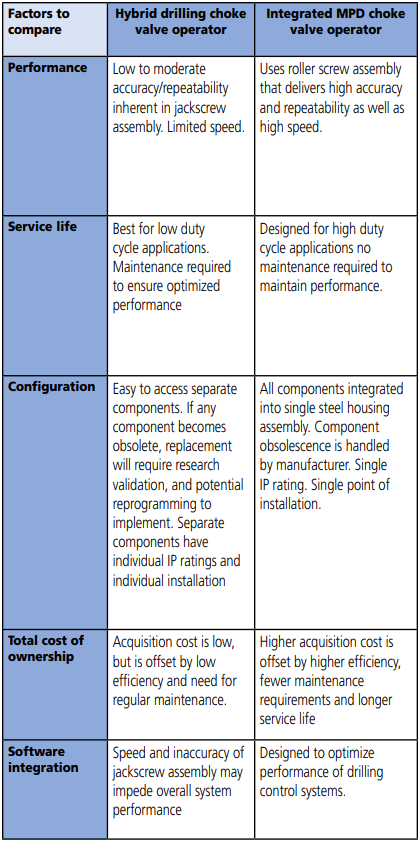
Hybrid Servo Motor Drilling Choke Operators
Description
The most common servo motor operated chokes today are hybrids; that is, a combination of new and old technologies. They combine a jack screw (old) with a brushless servo motor and planetary gear box (both new).
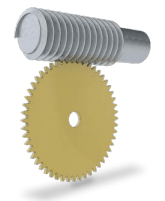
- The mechanical jack screw is comprised of a conventional worm screw/ bevel gear combination. This converts the rotary torque of the motor to linear motion and connects directly to the valve stem. The mechanical/ linear portion of the choke valve operator has been used reliably for many years in less demanding drilling applications in addition to MPD applications. Outside of the Oil &Gas Industry, this technology is commonly found in lift or hoist systems, solar panel arrays and machine base adjustment where they are ideally suited. The worm and bevel gear are often made of different metals, a situation that can cause wear problems and have duty cycle limitations.
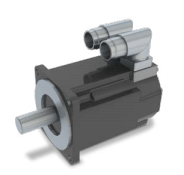
- The brushless servo motors used are rated for hazardous location operation and provide precise rotary position feedback via a high-resolution encoder. These motors are extremely reliable and provide very long service life. One thing to take note of when evaluating these motors is that they rarely carry multiple hazardous location certifications that would enable deployment on a global scale using a single motor. Typically these carry either an ATEX/IECEx or a Class I Div 1 rating.
Analysis
Performance
Accuracy/repeatability: Jack screw systems are not highly accurate and are commonly rated for duty cycles below 40%. Under high duty cycle conditions, wear on the drive gear is increased along with mechanical backlash (clearance) between the gear and the screw. This causes increased error in commanded versus actual position of the choke and requires maintenance/recalibration to maintain acceptable positioning accuracy. Initial values for backlash within these jack screw assemblies can range from approximately 0.002” to 0.010” (0.051 to 0.254mm). Not addressing this increase in backlash could result in improper and inconsistent pressure control.
Speed: The high reduction ratio in the hybrid’s mechanical systems reduces peak velocities to physically move the gate in the choke. This high reduction is necessary to ensure that the mechanical systems are fail in place which is required for choke valve applications. Full open to full close times with these systems are typically in the 7 second rage.
Environmental issues: The environment in which the operator is deployed will affect the overall survivability of any choke operator regardless of its design and configuration. In hybrid choke valve operators, each component may carry an individual IP rating and temperature rating; however, it is difficult to protect against ingress should there be pooling water within one of the connecting joints. Improper assembly can create unintended entry points for moisture and contamination. Since IP ratings are based on static conditions, this pooling water and other contamination could potentially migrate into these components when in operation.
Efficiency: A jack screw has low efficiency (30-40%) which leads to increased power consumption as well as slower system speeds. These inefficiencies lead to the use of high reduction ratio screw leads and gearboxes which contribute to these reduced speeds. They are also used to minimize the required power output of the motor to maintain a smaller envelope overall. This typically requires high voltage power sources (460/480 VAC) to ensure there is enough power to the system to reach peak velocity and thrust.
Service Life
Hybrid choke valve operators combine a sub-optimized mechanical jack screw system (low repeatability, low duty cycle) with a high-performance servo motor system. This combination may limit the amount of frequent pressure changes demanded to provide tight pressure control in an MPD operation. When using dissimilar metals as is commonly found in jack screw assemblies, modern engineering has yet to determine a means by which to predict effective service life. From installation to installation and site to site, effective service life of the jack screw assembly will vary.
Duty cycle and load (thrust applied) on the powertrain components directly contribute to mechanical wear in a non-linear manner. It is commonly understood that when these assemblies are operated outside of their stated duty cycle rating, wear is significantly accelerated which can contribute to premature or unpredictable failures. In situations where the duty cycle is required to be exceeded, the accelerated wear would require more frequent maintenance in addition to regular lubrication to prolong service life in this extreme operating condition.
Configuration and construction
Serviceability: A hybrid choke valve operator system has some advantage in serviceability since all the components are exposed and mated externally. In the event of a component failure, it can be replaced without the entire operator being returned to the manufacturer for service/repair. However, this creates more disassembly/re-assembly work in the field. Removing the gear-box would require removing the servo motor from the gearbox, the gearbox from the jack screw, replacing the new gearbox and then re-assembling the device.
Impact: Protruding elements (jack screw, gearbox, servo motor, linear transducer) of a hybrid assembly can increase the risk of damage due to shock or impact.
Weight distribution: The uneven weight distribution of a hybrid system can make it awkward to handle during installation or maintenance and subject to damage if mishandled.
Total cost of ownership
Initial cost: A hybrid system uses existing components, saving some cost. The jack screw assembly stays in place while the servo motor and planetary gearbox replace the hydraulic system. There is cost associated to the installation of all the components together onto the choke. Programming time is required when converting a full hydraulic system to electric and is unaffected by the style of choke operator being deployed.
Maintenance: As the gear/screw assembly is run over time, natural wear in the components due to their dissimilar materials causes increased backlash. Maintenance must be performed to bring the clearance back to the original value. (Manufacturers of these components often require regular service intervals to minimize the effects of wear between the two dissimilar metals of the gear and screw.) In applications such as MPD, where the duty cycle could be as high as 70-90% with regular pressure adjustments, frequent service may be needed.
Obsolescence: Hybrid systems contain individual components, often times made by multiple manufacturers, that require separate certifications and may become obsolete. If a component becomes obsolete, it requires an investment of additional engineering, validation and sourcing to ensure the new component functions properly. New components can change the dynamics of the system in terms power consumption, thermal rise, tuning and even scaling.
Software integration
When a hybrid choke valve operator is used, the speed of position changes directed by the drilling controls and may be faster than the choke operator can effectively reach a set-point. This can cause undershooting, overshooting and even pressure oscillations. Software developers may have limitations in how closely they can control pressure within their programming as a direct result of these mechanical limitations for speed and precision. Having an operator that can keep pace with software increases the potential for improved pressure control overall.
Furthermore, there are points within the CV curve of a choke valve where minute changes in gate position can cause dramatic changes in pressure. In certain scenarios (making connections, pump start-up and pump shut-down) where pressures are still required to be maintained while operating within this tight pressure band. In these instances if the system cannot see pressure change when executing the required positional change, oscillations could occur as the software continues to make moves that affect pressure which ultimately become larger than necessary due in part to the mechanical lash in the system.
Integrated Electric MPD Choke Valve Operator
Description
The alternative to the hybrid drilling choke valve operator is a new choke valve operator that is designed specifically for Managed Pressure Drilling with all the industrial automation-grade components integrated into a sealed enclosure assembly. Tolomatic’s integrated ServoChoke® electric choke valve actuator design utilizes roller screw technology in place of the mechanical jack screw making these operators ideally suited for continuous modulating applications such as MPD. The brushless servo motor, gear box and feedback device are all integrated inline into the actuator’s steel body enclosure to ncrease mechanical stiffness, improve overall responsiveness and minimize size/weight. An intermediary attachment to the bonnet and valve stem is all that’s needed for installation. Unlike stand alone Servo Motors, Servo Choke SVC is tri-certified for Class 1 Div 1, ATEX Zone 1, IECEx Zone 1 for Global Deployment without the need for any component/configuration changes.
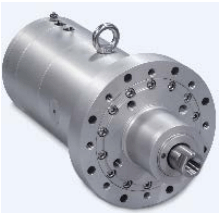
Roller screw advantages:
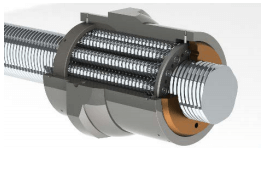
The use of a roller screw is critical to maximizing service life and precision performance in choke valve operators. Roller screws (also called planetary roller screws) are used in industrial applications where top performance, reliability, and long service life are required. Roller screw components are precision ground, made from hardened steel, and designed to provide more points of contact and a larger contact radius. The result is less stress per point and the primary reason for their durability. Since all the power transmission components are hardened, predicting service life with standardized L10 equations is easily accomplished.
Planetary roller screws also eliminate the restriction of duty cycle within the mechanical system. They can deliver high forces in a very compact envelope, operate at high speeds, offer long life and require little to no maintenance in many applications all while maintaining their initial backlash specification. This remains true even when very small individual movements under load are repeated continually within a small range of travel on the roller screw.
Analysis
Performance
Accuracy/repeatability: In an integrated MPD choke valve operator, the bevel gear/screw assembly of the jack screw is replaced with the more precise roller nut/screw assembly as the primary power transmission element. The rollers and screws are ground using precision equipment that ensure consistency from assembly to assembly and provide very high levels of repeatability – 0.051 to 0.012 mm (0.002” to 0.0005”) over the life of the device.
Speed: Roller screws are capable of high speeds and quick response without impacting backlash or service life.
Environmental issues: Specially-designed integrated MPD choke valve operators will carry an overall ingress protection (IP) rating rather than a component by component rating. The assembly is designed as one cohesive unit and ingress tested as such. A singular sealed enclosure eliminates the need for re-lubrication as it does not allow grease to escape. This ensures excellent protection of internal components by minimizing potential entry points for moisture and contamination and maintaining lubricity of critical components.
Service life
The effective service life of roller screw assemblies along with the other moving mechanical components can be predicted utilizing industry accepted B10 and L10 life calculations. If accurately sized for the application, specially-designed roller screw MPD choke valve operators can be deployed and classified as maintenance free. Effective service life can exceed 5 years of operation even when assuming they run continually (24/7) which is impractical during normal drilling operations.
Configuration and construction
General: An integrated MPD choke valve operator can be compact, stream-lined and designed to take up less space volumetrically than a conventional electric choke operator design. By using more efficient components, it is possible to get the required thrust from smaller components so the actuator/ operator is smaller.
Impact: In the event of an unintended but inevitable impact, critical components (encoder or other onboard electronics) stand a greater chance of surviving without harm since they are enclosed in the all steel housing. Mechanical joints and connections within the actuator are also protected as there are no exposed adapter plates, couplings or drive shafts that could be bent, damaged or destroyed from an external impact. Tolomatic conducted impact testing on their ServoChoke® SVC assembly where shock loads registering25g were see repeatedly while the actuator was in operation. Though this is not recommended, it does provide evidence that an integrated assembly can provide a measure of protection of internal components that conventional configurations cannot provide.
Obsolescence: A manufacturer supplying a fully integrated MPD choke valve operator can plan for dual sourced components and manage inventory accordingly. In the event of an unforeseen or planned discontinuation, the manufacturer can ensure little to no disruption in delivery and little or no impact to existing software or tuning parameters.
Total cost of ownership
Cost: An integrated electric drilling choke valve operator that is specifically designed for MPD may have a higher initial price than a hybrid system. With these actuator systems being extremely precise, accurate and long lasting, the variability in performance from one assembly to the next may not be ever noticed when exchanging one operator with another. This consistency has an impact on the total cost of ownership in reduced set-up and change over time when maintenance to the choke is required. This is also important in the event that an actuator has reached the end of its effective service life and needs to be replaced. Eliminating any mechanical adjustments or calibration processes increase uptime of the equipment which has a direct impact to reducing the total cost of ownership. Having a predictable service life can also allow for a longer depreciation of the equipment that, in a rental scenario, reduce the daily rates required to operate this equipment.
Efficiency: Roller screw efficiencies are typically about 85-90% efficient. When combined with high-efficiency servo technology, roller screws produce actuators with efficiencies in the 75% range. By using more efficient components to increase the overall mechanical efficiency, power consumption is reduced further adding to cost savings. By reducing the power requirements, integrated choke operators can achieve 75-80% of their peak velocities when run on 208 VAC with an average current draw of only 3Amps. Tolomatic’s ServoChoke® SVC can run on servo amplifiers with input voltages ranging from 208-480 VAC without making any electrical changes to the motor.
Maintenance: Due to the increase loading capacity (dynamic load rating) of a roller screw, this power screw can last much longer than any other screw technology on the market even in a smaller package and little or no maintenance is required.
Software integration
Integrated choke operators designed for Managed Pressure Drilling can work with fast processing speeds and deliver quick, precise movements. The combined performance aspects of a high resolution servo motor, minimized mechanical reduction, and the consistency of the roller screw eliminate the potential positioning challenges of a jack screw hybrid assembly. This allows the well control system to calculate a higher number of pressure changes with smaller steps resulting in better pressure control within a wellbore.
Conclusion

Oil and gas companies are adopting technologies from other industries as a way to compete in this challenging business environment. The industry’s objectives are to lower costs and spur advances in speed, precision and reliability. In drilling operations this means improving the overall pressure control of drilling chokes.
Hybrid drilling choke valve operator systems using a conventional jack screw mechanism combined with a high-performance servo motor have provided some advancements in precision and speed control in Managed Pressure Drilling applications. However, these choke valve operator systems are not fully optimized for MPD and limit the ability of well control systems to deliver faster processing speeds and better data acquisition. Tolomatic’s integrated ServoChoke® choke valve operator technology provides higher levels of accuracy/repeatability and speeds which enable enhanced pressure control. An integrated electric choke operator also delivers lower maintenance, longer service life, higher efficiency, higher duty cycle for demanding drilling times and lower total cost of ownership vs. its hybrid counterpart. Fully integrated MPD choke valve operators can also eliminate extra mechanical wind up due to multiple components being joined together with conventional mechanical interfaces. This increases system stiffness and further improves precision.

 Ask an Engineer
Ask an Engineer